

Storchschnäbel. Pelargonien und Geranien Bis ins späte 18.
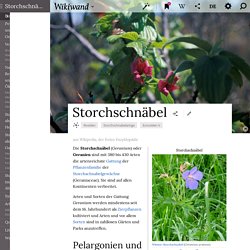
Jahrhundert wurden auch die als Beet- und Balkonpflanzen beliebten Pelargonien zur Gattung Geranium gezählt. Darauf weist der für diese Pflanzen noch heute in der Umgangssprache und im allgemeinen Handel gebräuchliche Begriff Geranien hin, der botanisch allerdings nicht korrekt ist. Denn Geranien (Geranium) und Pelargonien (Pelargonium) sind innerhalb der Storchschnabelgewächse zwei verschiedene Gattungen, die allerdings eng verwandt sind.
So gibt es einige wenige Geranienarten, die sich wie Pelargonien durch weiche, filzige Stängel und große Rundblätter auszeichnen und damit den Arten dieser Gattung sehr ähnlich sehen. Foraging and Feasting. Oregon State Noxious Weeds List. NRCS Invasive Species Policy Invasive Species Executive Order 13112 Oregon State-listed Noxious Weeds 273 records returned Click on an accepted name below to view its PLANTS Profile with more information, and web links if available.
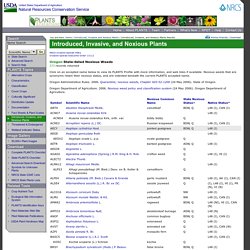
Noxious weeds that are synonyms retain their noxious status, and are indented beneath the current PLANTS accepted name. Oregon Administrative Rules. 2006. Plants (Kingdom Plantae) Description from View on Wikipedia → Green plants have cell walls with cellulose and obtain most of their energy from sunlight via photosynthesis by primary chloroplasts, derived from endosymbiosis with cyanobacteria.

Their chloroplasts contain chlorophylls a and b, which gives them their green color. Some plants are parasitic and have lost the ability to produce normal amounts of chlorophyll or to photosynthesize. Weed Profiles - Benton Soil & Water Conservation District. Imapinvasivesnetwork. WTU Herbarium Image Collection - Burke Museum. Consortium of Pacific Northwest Herbaria. Invasive Plant Atlas of the United States - Database of Plants Invading Natural Areas. Leafsnap: An Electronic Field Guide. The Silent Invasion: Quick Guide. Native plants. Once they're established in well-suited sites, many natives thrive without the need for much care, while bringing the beauty of our region's natural areas closer to home.

Weed Profiles - Benton Soil & Water Conservation District.
Roots - Brian McCauley. This page is part of the lab Plants II, which includes these lab pages: This lab is a continuation of Plants I, with the goal of helping you understand plant evolution, structure, and function.
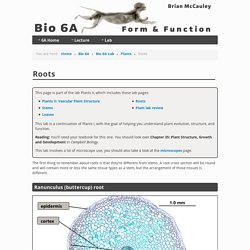
The Ohio State University at Lima. Alternate leaf arrangement.
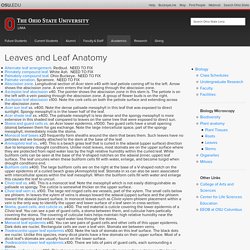
Redbud. NEED TO FIXPinnately compound leaf. Plant Structure and Function. Before we look at plant anatomy in detail, I want to caution you that we will be looking almost exclusively at Angiosperms, also know as flowering plants.
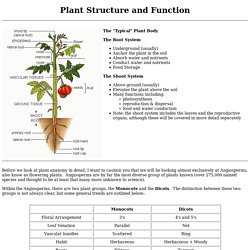
Angiosperms are by far the most diverse group of plants known (over 275,000 named species and thought to be at least that many more unknown to science). Within the Angiosperms, there are two plant groups, the Monocots and the Dicots. The distinction between these two groups is not always clear, but some general trends are outlined below: Organization of Plants and Animals - Cells, Tissues, Organs, Organ Systems.
Bio Lab. Chapter 35 - Plant Structure. Plants I - Evolution and Diversity, and Non-Vascular Plants - Biology 110 Master - Confluence. You should have a working knowledge of the following terms: Plants dominate the natural world and are the source of energy for the majority of other terrestrial organisms.
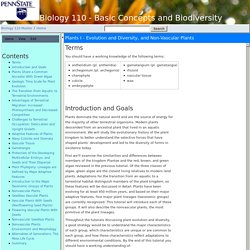
Modern plants descended from an ancestral plant that lived in an aquatic environment. We will study the evolutionary history of the plant kingdom to better understand the selective forces that have shaped plants' development and led to the diversity of forms in existence today. First we'll examine the similarities and differences between members of the kingdom Plantae and the red, brown, and green algae reviewed in the previous tutorial. Of the three classes of algae, green algae are the closest living relatives to modern land plants.
AP Biology - Chapter 36 Discussion Answers. 2. Plant water relations - BIOLOGY4ISC. Geotropism – a movement of plant organs brought about by gravity. Plant Structures: Stems. Thought Questions (Explain the science behind the questions.) • My trees have been under severe drought stress for the past few years.
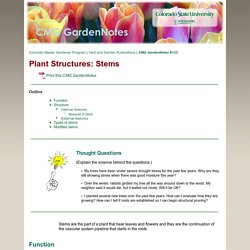
Why are they still showing stress when there was good moisture this year? • Over the winter, rabbits girdled my tree all the way around down to the wood. My neighbor said it would die, but it leafed out nicely. . • I planted several new trees over the past few years. ⚡Presentation "© 2011 Pearson Education, Inc. CHAPTER 11 Soil: The Foundation for Land Ecosystems." 18.8: Occurrence, Preparation, and Properties of Nitrogen. Soil structure, formation and type.
Soils have four main parts: water, air, minerals and organic matter, their relationships produce a number of properties found in soil which are outlined below.

Refers to the shape of peds (individual soil particles) and their grouping. The shape of peds, their alignments, along with particle size/texture determines the size and number of pore spaces. Structure can be improved by ploughing. Soil texture: How fine or course the mineral matter is in the soil that is dependent on the amount of sand, silt and clay particles in the soil. Polluted Rain - Google Books. Plant Pathology - Dr. P.D. Sharma - Google Books. Plant hormones. Chapter 22 Development of Plants. Plant responses. Chapter 5. PLANT ORGANS (ORGANOGRAPHY) Root provides the anchorage of the plant, as well as the adsorption of water and dissolved nutrients. 5.1.1. Longitudinal zonation pattern of the root In longitudinal section, root can be separated into well discernible zones. Root cap (calyptra) Its primary function is to protect the delicate apical region containing dividing cells. Besides, its outermost cell layer becomes slimy and is sloughed off, what eases the movement of the root within the soil.
Cytokinins. Plant Hormones-Cytokinins. While working on the callus under in vitro conditions, Cytokinins were discovered by Skoog and his students. They found the callus that develops from the stem explants, containing both pith and vascular elements, develops well. Primary Growth and Secondary Growth - Shmoop Biology. Primary Growth of Shoots Do plants grow from the top or the bottom? If you carve your name in a tree trunk, will it be at the same place in 10 years or will it move up the trunk? To know the answers to these questions, you need to understand primary growth and secondary growth.
First, let’s look at primary growth. Roots. Roots The root is one of the first parts of a plant that starts to grow. A primary root develops from a plant's seed and quickly produces branches called secondary roots. At the tip of each root is a rootcap that protects the delicate tip as it pushes through the soil. Threadlike root hairs grow farther back on the root. These hairs greatly increase the plant's ability to absorb water and minerals from the soil. Basic Principles of Pruning - How to Prune a Tree - Austin, Texas. Pruning is one of the most important cultural practices for maintaining woody plants, including ornamental trees and shrubs, fruits and nuts.
It involves both art and science: art in making the pruning cuts properly, and science in knowing how and when to prune for maximum benefits. There are numerous reasons for pruning. Sometimes you want to train or direct the growth of plants into a particular form or a specified space, like a formal hedge. Or you may want to prune mature plants to control their size and shape, as in the case of fruit trees that are pruned low to the ground to aid picking or hedge plants pruned at a particular height.
For fruiting plants, pruning plays an important role in improving overall fruit quality, primarily by increasing light penetration into the tree. Plant Life: Tropisms. Tropisms are the means by which plants grow toward or away from environmental stimuli such as light, gravity, objects to climb, moisture in soil, or the position of the sun. Although plants appear not to move, they have evolved adaptations to allow movement in response to various environmental stimuli; such mechanisms are called tropisms. There are several kinds of tropism, each of which is named for the stimulus that causes the response.
For example, gravitropism is a growth response to gravity, and phototropism is a growth response to unidirectional light. Tropisms are caused by differential growth, meaning that one side of the responding organ grows faster than the other side of the organ. Botany 223 Cheat Sheet by jhundal. ⚡Presentation "Plant Anatomy and Nutrient Transport Chapter 43. In order to survive, plants have to… The best ways to appreciate plants is to consider how they overcome." ⚡Presentation "Plant Form Chapter 36. 2 Plant Body Organization A vascular plant consists of: 1. Root system, which is underground -Anchors the plant, and is used to." Canada's Polar Life - Plant Biology.
Classify Chapter Frameset. Ch 43 lecture. ⚡Presentation "AP Biology Chapter 29 Seedless Plants: Bryophytes and Ferns." A Text Book Ofbotany: Plant Anatomy and Economic Botany - Pandey S N, S. N. Pandey, Ajanta Chadha - Google Books. Plant Vascular Architecture. Above: primary plant stem vascular tissue in cross-section. Plants Profile for Mahonia aquifolium (hollyleaved barberry) Pacific Northwest Plant Disease Handbook. Scientific Reports. What this handout is about. Presentation "UNIT IX – KINGDOM PLANTAE Big Campbell –Ch 29, 30, 35 – 39 Baby Campbell –Ch 17, 31 – 33 Hillis –Ch 21, 24 - 28." Root Types: Fibrous Root vs. Taproot System. <<< Back to Plant Structure main page Taproot vs.
Plant Structure and Function. Before we look at plant anatomy in detail, I want to caution you that we will be looking almost exclusively at Angiosperms, also know as flowering plants. Stems · Openstax Biology. Roots. Tall Oregon Grape (Mahonia [Berberis] aquifolium), Pacific northwest native shrub. Login. Bio 100 Chapter 21. Plant Tissue and Growth. Plant structure bi. At l'herbier: On the make // Botanical Herbarium Press. MakeHerbSpec.pdf. A Herbarium. Variation in Plant Life Cycles. Department of Botany. Botany Readings. Biological Diversity 5. Plants. Chapter 30 Presentation. Animation. Plant Life History Knowledge & Tribal Lore Implications from Native American Plant Names. Dyes. UM-Dearborn College of Arts, Sciences, and Letters. Native_American_Herbal_Plant_Knowledge_2004. Plants Used by Native Americans in the Oasis Valley-Beatty Museum and Historical Society - Preserving the Bullfrog Mining District - Beatty Nevada.
Native American Medicinal Plants. The Wild Garden: Hansen's Northwest Native Plant Database.